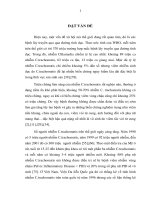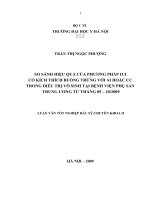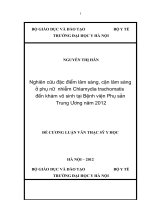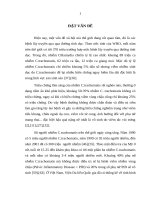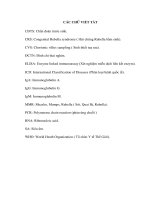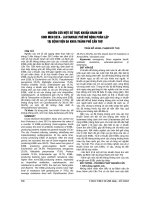Nghiên cứu một số dạng bất thường nhiễm sắc thể y ở nam giới khám vô sinh tại bệnh viện phụ sản thành phố cần thơ (tt)
Bạn đang xem bản rút gọn của tài liệu. Xem và tải ngay bản đầy đủ của tài liệu tại đây (481.9 KB, 29 trang )
MINISTRY OF EDUCATION AND TRAINING
CAN THO UNIVERSITY
SUMMARY OF DOCTORAL DISSERTATION
Specialization: Biotechnology
Code: 9 42 02 01
STUDY ON SOME KINDS OF Y-CHROMOSOMAL
ABNORMALITIES IN MEN SEEKING MEDICAL CARE
FOR THEIR FERTILITY AT CAN THO OBSTETRICS
AND GYNECOLOGY HOSPITAL
Can Tho, 2018
THE STUDY WAS COMPLETED AT
CAN THO UNIVERSITY
The dissertation was defended at the university examination
committee
At.………………………………………., Cantho University
At ……………………………………………………………
Reviewer 1:
Reviewer 2:
Reviewer 3:
The dissertation is available in Libraries:
1. Central Library of Can Tho University.
2. National Library of Vietnam.
LIST OF PUBLICATION RELATED TO THE THESIS
1. Cao Thi Tai Nguyen, Nguyen Trung Kien, Vu Thi Nhuan
Nguyen Chung Vieng, Trinh Thi Bich Lien (2017), “Detection of
AZFc microdeletions on Y chromosome in male infertility by
QF-PCR assay”, Vietnam Medical Journal. No 2/2017, pp. 245249.
2. Cao Thi Tai Nguyen, Trinh Thi Bich Lien, Nguyen Trung Kien,
Vu Thi Nhuan, Nguyen Phan Vinh, Nguyen Thi Bich Ngoc,
Trinh Minh Thiet, Phan Thi Nhan (2017), “Hormone FSH, LH
and testosteronee of severe oligozoospermia and azoospermia
male”, Journal of Practical Medicine. No 5(1043)/2017, pp.
178-181.
3. Cao Thi Tai Nguyen, Nguyen Trung Kien, Vu Thi Nhuan,
Nguyen Chung Vieng, Trinh Minh Thiet, Nguyen Phan Vinh,
Nguyen Thi Bich Ngoc, Cao Luong Binh, Trinh Thi Bich Lien
(2017), “An infertility SRY-negative 46,XX male detected by
quantitative fluorescent polymerase chain reaction”, Journal of
clinical case reports. 7:1013, doi: 10.4172/21657920.10001013.
4. Cao Thi Tai Nguyen, Nguyen Trung Kien, Trinh Thi Bich Lien,
Vu Thi Nhuan, Nguyen Chung Vieng, Nguyen Dac Khoa,
Nguyen Thi Bich Ngoc, Trinh Minh Thiet, Cao Luong Binh,
Nguyen Phan Vinh, Nguyen Van Khuon (2018), “Using QF-PCR
assay in detection of common genetic causes in infertile males”,
Journal of Biotechnology. No 16(2), pp. 241-252.
1
Chapter 1
INTRODUCTION
1.1. Background
Genetic factors are highlighted as the most frequent, contributed to
4-38%, of male infertility causes. Up to date, Klinefelter syndrome and
AZF deletions are common genetic causes in infertily men. In Vietnam,
these causes accounted for 23.1% in infertile males with sperm
concentration ≤ 5 million/mL. Moreover, the proportion of Vietnamese
infertile men with AZF deletions was range 5-12.8% in previous studies.
There are 3 kinds of AZF deletions as AZFa, AZFb and AZFc.
Men with AZFc deletion can have a baby with his wife/partner due to
reproductive technology (a successful rate was 70%), and others are very
difficult for his wife/partner to have been pregnanced. European Academy
of Andrology and European Molecular Genetics Quality Network
(EAA/EMQN) recommend that men with sperm concentration < 5
million/mL should perform tests for genetic abnormalities before using
assisted reproduction (Krausz et al., 2014).
QF-PCR assay has many advantages such as fast feedback time,
low cost, high accuracy; so many authors propose to use this technique in
diagnosis of genetic causes in infertile men. That is the reason behind the
study of “Study on some kinds of Y-chromosomal abnormalities in
men seeking medical care for their fertility at Can Tho Obstetrics and
Gynecology hospital”.
1.2. Objectives
(1) To set up and to assure the procedure of QF-PCR assay using
for detecting some kinds of Y-chromosomal abnormalities in men with
sperm concentration ≤ 5 million/mL.
(2) To determine the percentage of some kinds of Y-chromosomal
abnormalities in men with sperm concentration ≤ 5 million/mL by the
setted up and assured procedure of QF-PCR assay.
(3) To describe characteristics of semenogram, endrocrines and
some factors related to Y-chromosomal abnormalities in men with sperm
concentration ≤ 5 million/mL.
1.3. Scientific significance of the dissertation
1.3.1. Scientific and educational values
- Providing scientific data on the percentage of some kinds of Ychrosomal abnormalities, characteristics of semenogram, endrocrines and
2
some factors related to Y-chromosomal abnormalities in men with sperm
concentration ≤ 5 million/mL.
- Making the premise for the following studies.
1.3.2. Practical values
This research has a great significance in supporting the diagnosis,
counseling and treatment of infertility effectively and inexpensively in
patients at Can Tho Obstetrics and Gynecology Hospital in particular and
in the Mekong Delta in general.
1.4. New contributions of the dissertation
- The study was setted up and optimized a successful procedure of
QF-PCR assay with 14 genetic markers (AMEL, SRY, sY1191, sY1192,
TAF9B, DAZ, CDY, sY84, sY86, sY127, sY134, sY254, sY255 and
sY1291) for detecting Y-chromosomal abnormalities in men seeking
medical care for their fertility.
- The study of Rozen et al. (2012) was firstly indicated that there
were 2 kinds of partial AZFc deletion in Vietnamese: gr/gr and b2/b3.
Besides two of these deletions, 4 de novo mutations were found in our
research as sY1191-sY1192 deletion, sY1291 deletion, 2 DAZ – 1 CDY1
deletion and 1 CDY1 deletion.
- The thesis was noted that the length polymorphism of sY1291
fragment, ranging from 507 bp – 527 bp.
Chapter 2
OVERVIEW MATERIALS
2.1. General of infertility and spermatogenesis
2.1.1. Definition of infertility and male infertility
About 80-85% of couples achieve pregnancy after 1 year living
together; but about 15-20% of them have trouble in fertility, also known as
infertility (Ayensu-Coker et al., 2007; Jungwirth et al., 2012).
Infertility is the inability of a sexually active, noncontracepting
couple to achieve pregnancy in one year (WHO, 2000).
Male infertility is the status of couples does not achieve pregnancy
after 1 year of unprotected intercourse and without using contraceptive
method caused by men (Jungwirth et al., 2012).
2.1.2. General of spermatogenesis
The spermatogonium take part in spermatogenesis and undergo 3
stages as mitotic division, meiosis and differentiation to create mature
3
sperm (Oliveira and Alves, 2015). A fertile man produces more than 40
million spermatozoa per day (Cheng and Mruk, 2013).
Three main hormones regulate in spermatogenesis are FSH (FSH Follicle-stimulating hormon), LH (LH - Luteinizing hormon) and
testosterone (Verhoeven et al., 2010; Rato et al., 2012). Besides, this
process is regulated by some other factors such as temperature, reactive
oxygen species (ROS) and antioxidant defence at testis (Oliveira and
Alves, 2015).
Testing for FSH, LH, and testosterone concentrations are
important and necessary to figure out causes and treatments for male
infertility caused by hormone (Hotaling and Walsh, 2009).
2.2. Semenogram and some risk factors of male infertility
2.2.1. Semenogram
Up to now, most testing labs evaluate semenogram based on WHO
guidelines (2010).
2.2.2. Some risk factors of male infertility
Some risk factors relate to male infertility have been identified
such as age, body mass index (BMI), family history of infertility, some of
life habits (smoking, drinking, low physical activity), toxic enviroment,
professions exposure to high temperatures, tight underwear and steam bath
(Cavallini and Beretta, 2015).
2.3. Y chromosome and some kinds of Y-chromosomal abnormalities
in male infertility
2.3.1. Y chromosome
Y chromosome is approximately 60 Mb in size and includes two
segments, pseudoautosomal regions (5%) and non-combining region (also
known as male-specific region of Y chromosome (MSY)) (Jangravi et al.,
2013). MSY comprises 95% of Y chromosome’s length and has 2 regions.
They are euchromatin and heterochromatin (Fig.1).
Fig 2.1. Structure of Y chromosome (Kandeel et al., 2007).
4
2.3.2. Some genetic markers on Y chromosome
The MSY database contains many genetic markers. For example,
there are 1.287 Y-specific sequence tagged sites (STSs) on Y
chromosome, in which 992 STSs are single-copy and 285 STSs are
multiple-copy (Lange et al., 2008).
Until now, most of studies have been used 6 genetic markers
(sY84, sY86, sY127, sY134, sY254 and sY255) to detect AZFa, AZFb
and AZFc deletions (Krausz et al., 2014). Moreover, Rozen et al. (2012)
used sY1189, sY1191, sY1192 and sY1291 markers to detect partial
AZFc deletions. Based on these evidents, the study was used sY84, sY86,
sY127, sY134, sY254, sY255, sY1191, sY1192 and sY1291 markesrs. In
addition, our study was used AMEL, TAF9B, DAZ, CDY, SRY markers
to detect some kinds of Y-chromosomal abnormalities. In conclusion, the
thesis were used 14 genetic markers.
All primer sequences of genetic markers were tested on the NCBI
(Version GRCh38.p7) to detect the location of the PCR fragments. Figure
2.2 was presented the amplified PCR fragments of 13 genetic markers on
Y chromosome, excluded TAF9B marker (amplifying PCR fragments on
chromosome 3 and X chromosome).
Fig. 2.2. PCR fragments were amplified by the genetic markers on
Y chromosome.
5
2.3.3. Y chromosome abnormalities in male infertility
The genetic causes accounted for 30% includes single gene
disorders, cell genetic abnormalities and AZF mutations on Y
chromosome (Aston and Conrad, 2013).
2.4. Some assays using to detect genetic causes in male infertility
Currently, not only cell genetic engineering but also many
molecular assays have been used to detect abnormalities on Y
chromosome. Fluorescence in situ hybridization (FISH), Multiplex-PCR,
Realtime PCR, Multiplex ligation dependent probe amplification (MLPA)
and Quantitative flourescence (QF-PCR) are molecular assays.
2.5. Scientific situation of genetic causes in men
2.5.1. In the world
Many studies have shown that Klinefelter syndrome and AZF
deletions are two of the most common genetic causes in infertility male
with sperm concentration < 5 million/mL (Cavkaytar et al., 2012; Choi et
al., 2013; Zhang et al., 2013b). The percentage of AZF deletions were 438% (Mafra et al., 2011; Cavkaytar et al., 2012; Fu et al., 2012; Choi et
al., 2013; Ambulkar et al., 2013; Nasasse et al., 2015).
2.5.2. In Vietnam
The ratio of AZF deletions accounted for 5-12.8%; in which AZFc
deletion was the most prevalent (Nguyen Minh Ha, 2011; Nguyen Thi
Viet Ha, 2012; Nguyen Duc Nhu, 2015).
6
Chapter 3
STUDY METHODS
3.1. The main workups in research
Fig.3.1. The primary steps in research.
3.2. Study subjects
Men seeking medical care for their fertility had sperm
concentration ≤ 5 million/mL at Infertility Department – Can Tho
Obstetrics and Gynecology Hospital, according to WHO guidelines
(2010).
7
Exclusion criteria: men who did not get semen by masturbation and
consent to participation in the study. Additionally, men with ligation and
vasectomy, taking sample at home and dropping sperm were excluded.
3.3. Sample size
- To apply the sample size estimation for a proportion.
n Z12 / 2 .
p.(1 p)
d2
Where: n: sample size.
Z1-/2 = 1,96 with confidence interval is 95%.
p: the percentage of men seeking medical care for their fertility
having sperm concentration ≤ 5 million/mL had AZF deletions on Y
chromosome. Basing on the study of Nguyen Minh Ha (2011), the p value
was 12.8% (p = 0.128).
d: desired precision, d = 0,037.
n = 313 patients.
Conclusion, number of sample size was 313 men seeking medical
care for their fertility having sperm concentration ≤ 5 million/mL.
In fact, 322 subjects were studied.
3.4. A sampling method
The patients were chosen conveniently without probability.
3.5. Time and places
3.5.1. Study time
From November 2014 to March 2017.
3.5.2. Study places
- Getting, testing and analysing semen samples were processed at
Infertility Department – Can Tho Obstetrics and Gynecology Hospital.
- Testing for FSH, LH and testosterone levels; extracting DNA,
doing QF-PCR assay and sequencing were performed at Genetics Analysis Department – Can Tho Obstetrics and Gynecology Hospital.
- Sending one blood sample and 3 DNA samples to test the QFPCR results were done by the ISOLABO lab at 101/26 Nguyen Chi Thanh
street, 9 Area, 5 District, Ho Chi Minh city.
3.6. Equipments, instruments and chemicals
- The research was used the chemicals and equipments to test for
semens, endocrines, genetics (QF-PCR assay) and sequences.
- 14 primers (reverse primers) and fluorescent primers (forward
primers) of genetic markers were shown in Table 3.1A.
8
Table 3.1A. Genetic markers for detecting some kinds of Y-chromosomal abnormalities in patients
Genetic
markers
sY84-F
sY84-R
sY86-F
sY86-R
sY127-F
sY127-R
sY134-F
sY134-R
sY254-F
sY254-R
sY255-F
sY255-R
sY1191-F
sY1191-R
sY1192-F
sY1192-R
sY1291-F
sY1291-R
SRY-F
SRY-R
CDY-F
CDY-R
AMEL-F
AMEL-R
TAF9B-F
TAF9B-R
DAZ-F
DAZ-R
Chromosome
region
AZFa
AZFa
AZFb
AZFb
AZFc
AZFc
AZFc
AZFc
AZFc
Yp11.2- p22.1
AZFc
AZFb
Xp22.1-p22.31
Yp11.2 - p22.1
X chromosome
Chromosome 3
AZFc
Chromosome 3
Sequence of the primers (5’-3’)
F: AGAAGGGTCCTGAAAGCAGGT
R: GCCTACTACCTGGAGGCTTC
F: GTGACACACAGACTATGCTTC
R: ACACACAGAGGGACAACCCT
F: GCACCCACTGGAATCTACC
R: CATGGCTACACAGACAGGGA
F: GTCTGCCTCACCATAAAACG
R: ACCACTGCCAAAACTTTCAA
F: GGGTGTTACCAGAAGGCAAA
R: GAACCGTATCTACCAAAGCAGC
F: GTTACAGGATTCGGCGTGAT
R: CTCGTCATGTGCAGCCAC
F: CCAGACGTTCTACCCTTTCG
R: GAGCCGAGATCCAGTTACCA
F: ACTACCATTTCTGGAAGCCGG
R: CTCCCTTGGTTCATGCCATT
F: TAAAAGGCAGAACTGCCAGG
R: GGGAGAAAAGTTCTGCAACGT
F: GAATATTCCCGCTCTCCGGA
R: GCTGGTGCTCCATTCTTGAG
F: GTTTCTTCCACTGTAGAAATTCACCTCC
R: GAAGTTTGCATAGTGGACAGC
F: CCCTGGGCTCTGTAAAGAATAGTG
R: ATCAGAGCTTAAACTGGGAAGCTG
F: TTTGACAGGTAGTTTTGGGTCA
R: TGGTTTTGCCTAGGTCCAGT
F: TTAAGTACTACTGTAGACACC
R: GTTTCTTGTATAATGTAGAAGAGTAGAGC
9
Fluorescent
label
NED
PCR reference product sizes
range in bp (NCBI, GRCh38.p7)
326
VIC
318
FAM
195
NED
301
FAM
380
FAM
123
VIC
385
NED
255
VIC
527
FAM
472
VIC
200
194
106
112
144
140
214
217
FAM
FAM
FAM
References
Krausz et al.
(2014)
Krausz et al.
(2014)
Fu et al.
(2012)
Krausz et al.
(2014)
Krausz et al.
(2014)
Krausz et al.
(2014)
Krausz et al.
(2014)
Krausz et al.
(2014)
Fu et al.
(2012)
Plaseska et al.
(2011)
Xie và Liang et al.
(2014)
Plaseska et al.
(2011)
Alimardanian et al.
(2016)
- Negative controls (pure water, DNA of healthy female) and
positive controls (DNA of infertile males with AZFc deletion and
Klinefelter syndrome were provided by the Department of Biomedical Genetics – Hanoi Medical University and Medical Military Academy).
+ Primers of sY1291 were produced by Macrogen company,
Korea and primers of LAPT were making not only by Macrogen
company, Korea but also by Phusa bio chemistry Co. LTD, Can Tho,
Vietnam (Table 3.1B).
Table 3.1B. Some characteristics of sY1291 and LAPT genetic markers
Genetic
markers
sY1291
LAPT
Sequence of the primers (5’-3’)
PCR reference product sizes
range in bp (NCBI, GRCh38.p7)
F: TAAAAGGCAGAACTGCCAGG
R: GGGAGAAAAGTTCTGCAACGT
527
F: CAGAACTGCCAGGTCTGTGTCTTAT
R: ACCATCCCGGCTAAAAACGGTG
288
3.3. Study methods
3.3.1. To set up and to test the procedure of QF-PCR assay using for
detecting some kinds of Y-chromosomal abnormalities in men with
sperm concentration ≤ 5 million/mL
3.3.1.1. DNA extraction
3.3.1.2. To set up the procedure of QF-PCR assay
The thesis was examined the conditions of QF-PCR assay and
capillary electrophoresis to set up and optimize the procedure of QF-PCR
assay.
a. To examine the conditions of QF-PCR assay
To determine the annealing temperature of each genetic marker,
we had surfed the NEB calculator Tm at />Genetic markers were arranged into groups based on annealing
primer and optimize annealing temperature and practical conditions.
The final concentration of primers in QF-PCR assay was tested on
5 pmol and 10 pmol. Similarly, multiplex PCR mastermix was tested with
concentrations of 1X and 2X. Moreover, total volume was done with 25 μl
and 50 μl.
The optimal conditions of genetic markers in QF-PCR assay were
figured out by these above conditions.
b. To investigate the conditions of capillary electrophoresis of
fluorescent PCR fragments
10
HiDi-Formamide (HiDi) and standard marker were diluted in
volumes of 200 μl HiDi + 4 μl standard markers and 120 μl HiDi + 4 μl
standard markers.
The fluorescent PCR fragments were diluted with double
deionized water (Table 3.2).
Table 3.2. Diluted volumes of the fluorescent PCR fragments
Final volume for making
capillary electropherosis
0,5 µl
0,5 µl
0,5 µl
Diluted volumes
The fluorescent PCR
Dideionized water
fragments
0,5 µl
20 µl
0,5 µl
30 µl
0,5 µl
50 µl
The conditions of capillary electropherosis were performed
according to Devyser and Elucigen’s programs were setted up on ABI
3500 Genetics Analysis.
Basing on the QF-PCR results, the conditions of capillary
electrophoresis were choosen.
c. QF-PCR results
To analysis the results by Genemarker software V2.6.3 and to take
note the results were presented by peaks of fluorescent PCR fragments and
labeled by FAM (blue), VIC (green) and NED (black).
3.3.1.2. Testing for the procedure of QF-PCR assay
To assess the accuracy and reliability of the developed and
optimized procedures, the QF-PCR results were verified in the following
ways:
- Comparison of the research results to data on NCBI
(GRCh38.p7) and some studies in the world.
- Comparison of the research results to the positive controls being
provided by the Department of Biomedical - Genetics - Hanoi Medical
University and Medical Military Academy.
- Sending a blood sample and DNA samples of study subjects for
confirming the QF-PCR results.
- Sequencing to determine the length polymorphism of fluorescent
PCR fragments amplified by sY1291 marker.
3.3.2. To determine the percentage of some kinds of Y-chromosomal
abnormalities in men with sperm concentration ≤ 5 million/mL by the
developed and tested procedure of QF-PCR assay
11
The developed and tested procedure of QF-PCR assay was applied
to identify some kinds of Y-chromosomal abnormalities.
The QF-PCR result of men without Y-chromosomal abnormalities
was shown by AMELX/AMELY ratio of 1:1 (103-106 bp), DAZ/DAZL ratio
of 4:2 (210-214 bp), CDY2/CDY1 ratio of 2:2 (198-204 bp). The nonpolymorphis SRY, sY84, sY86, sY127, sY134, sY254, sY255, sY1191,
sY1192 gave PCR fragments of 465 bp, 328 bp, 316 bp, 192 bp, 302 bp,
380 bp, 122 bp, 385 bp and 255 bp, respectively. Especially, PCR
fragments of sY1291 were presented in one of the following locations:
507 bp or 512 bp or 523 bp or 527 bp.
The QF-PCR result of men with partial AZFb deletion (two CDY2
deletion) was shown CDY2/CDY1 ratio of 0:2 and the other peaks were
similar to the QF-PCR result of a man without Y-chromosomal
abnormality.
The QF-PCR result of men with partial AZFc deletion (gr/gr
deletion) was shown DAZ/DAZL ratio of 2:2; CDY2/CDY1 ratio of 2:1, no
PCR fragment of sY1291 and the other peaks were similar to the QF-PCR
result of a man without Y-chromosomal abnormality.
The QF-PCR result of men with partial AZFc deletion (b2/b3
deletion) was shown DAZ/DAZL ratio of 2:2, CDY2/CDY1 ratio of 2:1, no
PCR fragments of sY1191 and sY1192, and the other peaks were similar
to the QF-PCR result of a man without Y-chromosomal abnormality.
The QF-PCR result of men with partial AZFc deletion (two DAZ
deletion) was shown DAZ/DAZL ratio of 2:2 and the other peaks were
similar to the QF-PCR result of a man without Y-chromosomal
abnormality.
The QF-PCR result of men with partial AZFc deletion (two DAZ one CDY1 deletion) was shown DAZ/DAZL ratio of 2:2, CDY2/CDY1 ratio
of 2:1 and the other peaks were similar to the QF-PCR result of a man
without Y-chromosomal abnormality.
The QF-PCR result of men with partial AZFc deletion (sY1191sY1192 deletion) was shown the absent peak of sY1191-sY1192
fragments; the other peaks were similar to the QF-PCR of a man without
Y-chromosomal abnormality.
The QF-PCR result of men with partial AZFc deletion (sY1291
deletion) was shown the absent peak of sY1291 fragments; the other peaks
were similar to the QF-PCR result of a man without Y-chromosomal
abnormality.
12
The QF-PCR result of men with complete AZFc deletion (also
known as b2/b4 deletion) was shown the absent peak of sY254, sY255,
sY1191, sY1192 and sY1291 fragments; DAZ/DAZL ratio of 0:2,
CDY2/CDY1 ratio of 2:0 and the other peaks were similar to the QF-PCR
result of a man without Y-chromosomal abnormality.
The QF-PCR result of men with complete AZFbc deletion was
shown the absent peak of sY127, sY134, sY254, sY255, sY1191, sY1192
CDY2/CDY1 and sY1291 fragments; DAZ/DAZL ratio of 0:2 and the other
peaks were similar to the QF-PCR result of a man without Ychromosomal abnormality.
The QF-PCR result of men with DAZ duplication was shown
DAZ/DAZL ratio of 6:2 or 8:2; the other peaks were similar to the QF-PCR
result of a man without Y-chromosomal abnormality.
The QF-PCR result of men with not only Klinefelter syndrome but
also gr/gr deletion was shown AMELX/AMELY ratio of 2:1;
TAF9B3/TAF9BX ratio of 2:2 and the other peaks were similar to the QFPCR result of a man with gr/gr deletion.
The QF-PCR result of men with not only Klinefelter syndrome but
also gr/gr deletion was shown AMELX/AMELY ratio of 2:1;
TAF9B3/TAF9BX ratio of 2:2 and the other peaks were similar to the QFPCR result of a man with DAZ duplication.
The QF-PCR result of men with not only Klinefelter syndrome but
also gr/gr deletion was shown AMELX/AMELY ratio of 2:1;
TAF9B3/TAF9BX ratio of 2:2 and the other peaks were similar to the QFPCR result of a man with DAZ deletion.
3.3.3. To describe characteristics of semenogram, endocrines and
some factors related to Y-chromosomal abnormalities in men with
sperm concentration ≤ 5 million/mL
- To counsel and instruct for patients the way of collecting semen.
- To evaluate of seminal parameters according to WHO guidelines
(2010).
- To interview the patients based on the questionnaire form.
- To examine clinic: BMI, genital abnormalities.
- To test endocrine of the pituitary-testicular axis.
- To analyze the results.
13
Chapter 4
RESULTS AND DISCUSSIONS
4.1. To set up and to test the procedure of QF-PCR assay using for
detecting some kinds of Y-chromosomal abnormalities in men with
sperm concentration ≤ 5 million/mL
4.1.1. To set up the procedure of QF-PCR assay
4.1.1.1. To examine the conditions of QF-PCR assay
Experimentally, the thesis had been optimized the annealing
temperature in QF-PCR assay and was divided into 3 sets. Set 1 consisted
of 4 genetic markers (sY254, sY255, sY1191, sY1192) and set 2 had 5
genetic markers (AMEL, CDY, DAZ, TAF9B, SRY) with annealing
temperature of 560C. Set 3 consisted of 5 genetic markers (sY84, sY86,
sY127, sY1291, sY134) with annealing temperature of 580C. Besides
annealing temperature, final concentration and total volume of QF-PCR
assay were optimized as 5 pmol and 25 μl, respectively. In addition,
multiplex PCR 5X mastermix was also optimized in QF-PCR assay with a
final concentration of 1X.
The cycling conditions of set 1 and set 2 were the following:
940C - 2 minutes, {[940C - 30 seconds, 560C - 1 minute, 680C - 1
minute 30 seconds], 30 cycles}, 680C - 10 minutes, 40C - ∞
The cycling condition of QF-PCR in set 3 had done similarly to set
1 and set 2, except that annealing temperature was 580C.
Compared with the other studies, the differences in conditions,
annealing temperature, and thermal cycle of the procedure of QF-PCR
assay were probably understood due to the different types of chemicals
and experimental conditions.
4.1.1.2. To investigate the conditions of capillary electropherosis of
fluorescent PCR fragments
The thesis was used the procedure of the following capillary
electrophoresis: mix 3 sets of fluorescent PCR fragments into one tube.
Each tube contained 8 μL Hidiformamide and standard marker + 0.5μL
fluorescent PCR fragments which were diluted 100 times and placed in
ABI 3500 Genetic Analyzer according to the Devyser or Elucigen
programs. The results were analyzed by Genemarker software V2.6.3.
4.1.1.3. Results of QF-PCR
With the optimized QF-PCR procedure, the results were shown by
peaks of the fluorescent PCR fragments which were amplified by genetic
14
markers. One primer in each genetic marker was labeled with FAM or
HEX or NED fluorescent dye, which allowed the determination of the
length of the different STR and STS alleles and for quantification of the
relative AMELX/AMELY, TAF9BX/TAF9B3, DAZ/DAZL and CDY2/CDY1
ratios.
The primers of genetic markers was labeled with FAM fluorescent
dye included: AMEL, sY255, TAF9B (T3), sY127, DAZ, sY254 and
SRY. Fluorescent PCR fragments of this group were demonstrated by blue
peaks (Fig. 4.1).
Fig. 4.1. Electrophoretogram of the QF-PCR analysis amplified by
markers was labeled with FAM fluorescent dye.
With the optimal procedure, the normal results in a male DNA
samples are presented by an AMELX/AMELY ratio of 1, due to the
presence of one X and one Y chromosome, DAZ/DAZL ratio of 2, due to
the presence of 4 DAZ genes in the AZFc region of Y chromosome and
two DAZL genes, one on each chromosome 3. The normal
TAF9BX/TAF9B3 ratio is 0.5 due to the presence of two copies of the gene
on the chromosomes 3 and one copy on the chromosome X in males. The
four STR markers on chromosome X, as well as the one in the AZFb
region on chromosome Y generate one PCR fragment due to the presence
of one allele of each of the investigated markers. The non-polymorphic
markers on Y chromosome: SRY, sY127 and sY254 gave PCR fragments
of 465 bp, 192 bp and 380 bp in males without AZF rearrangements (Fig.
4.1).
The primers of genetic markers was labeled with VIC fluorescent
dye included: CDY, sY86, sY1191 and sY1291. PCR fragments of this
group were demonstrated by green peaks (Fig. 4.2).
15
Fig. 4.2. Electrophoretogram of the QF-PCR analysis amplified by
markers was labeled with VIC fluorescent dye.
The normal results in a male DNA samples are presented by
CDY2/CDY1 ratio of 1, due to the presence of 2 CDY2 genes in the AZFb
and 2 CDY1 genes in the AZFc region of Y chromosome. The nonplymorphic markers on Y chromosome: sY86 and sY1191 gave PCR
fragments of 316 bp and 385 bp in males without AZF rearrangements
(Fig. 4.2).
SY1291 fragments were found to be polymorphic in size: 507bp,
512 bp, 523 bp and 527 bp in patients (Fig. 4.3). This meant there was a
length polymorphism of sY1291 fragments. This finding was in
concordance with the results described by Lin et al. (2006) and Evguenia
(2016). To confirm the length polymorphism of sY 1291 fragments, our
research was used sequencing assay and was presented more detail in
4.1.2.
Fig. 4.3. The length polymorphism of sY1291 fragments.
The primers of genetic markers was labeled with NED fluorescent
dye included: sY1192, sY134 and sY84. PCR fragments of this group
were demonstrated by black peaks (Fig. 4.4).
16
Fig. 4.4. Electrophoretogram of the QF-PCR analysis amplified by
markers was labeled with NED fluorescent dye.
The non-plymorphic markers on Y chromosome: sY1192, sY134
and sY84 gave PCR fragments of 255 bp, 302 bp and 328 bp in males
without AZF rearrangements (Fig. 4.4).
Moreover, there were a lot of extra peaks in Figures 4.1, 4.2 and
4.4. These extra peaks may be explained due to non-specific fluorescent
PCR fragments. This was caused by some primers of genetic markers can
amplify the fragments that had > 600 bp in length, so the sizes of PCR
fragments was shown to be shorter products (NCBI, GRCh38. p7).
4.1.2. Testing for the procedure of QF-PCR assay
4.1.2.1. Comparison of the research results to data on NCBI
(GRCh38.p7) and some studies in the world
The QF-PCR results were indicated that the sizes of the fluorescent
PCR fragments were divided into three groups. Group 1 was amplified by
sY84, sY254, sY1191 and sY1192 had fluorescent PCR fragments as
equal as reference PCR fragments. Group 2 was amplified by SRY, sY86,
sY127, sY255, CDY, AMEL, TAF9B and DAZ had the size of fluorescent
PCR fragments less 2-5 bp than the reference PCR fragments. Group 3
had a longer fluorescent PCR fragment than the reference PCR was
amplified by sY134. Moreover, our study was indicated that sY1291 has a
fluorescent PCR fragments which were shorter than 4-20 nucleotides (507
bp, 512 bp, 523 bp) or equal to a reference PCR fragment (527 bp).
Comparing with the study of Plaseska et al. (2011), the results
were consistent in size of fluorescent PCR fragments in groups 2 and 3. In
group 2, the authors noted that the size of SRY fluorescence PCR fragment
was 243 bp, shorter than 5 nucleotides compared to the expected gene size
of 248 bp. The difference was due to the use of other primitive sequences.
The results were consistent with studies by Plaseska et al. (2011) and
Papoulidis et al. (2012) is 103 bp and 109 bp. Another study by Fodor et
al. (2007) and Majumder et al. (2015) also noted the fluorescence range of
PCR fragments of 104 bp and 110 bp.
17
Thus, the fluorescence PCR fragments’ size may be 2-3 bp shorter
than the reference PCR fragments’ size due to different QF-PCR reaction
conditions. This is totally suitable with the recommendation offering in
Devyser kit for detecting AZF deletions.
Thus, the peak positions of fluorescent PCR fragments may be
equal, shorter or longer than the reference PCR fragments. The results of
the thesis were shown that most of PCR fragments were 2-5 bp shorter or
longer than the reference PCR fragments; except fluorescent PCR
fragments amplified by sY1291. They were presented the length
polymorphism in length.
4.1.2.2. Comparison of the research results to the positive controls
The study was carried out the positive controls (the ADN samples
with AZFc deletion and Klinefelter syndrome). In our study, QF-PCR
results were similar to the results of positive controls. Thus, the optimized
the procedure of QF-PCR assay was given similar results to other assays.
4.1.2.3. Sending a blood sample and DNA samples of study subjects
for confirming the QF-PCR results
The confirming results of a blood sample also had shown that
patient had an extra X chromosome (totally, 47 chromosomes) by
culturing of peripheral blood lymphocyte, similar to the QF-PCR result. In
addition, the thesis was randomly selected three samples of DNA (one
healthy DNA sample, one DNA sample having complete AZFbc deletion
and one DNA sample having completed AZFc deletion) for submitting to
the ISOLABO laboratory. By using Devyser kit, they also gave the same
results with our QF-PCR results.
4.1.2.4. Sequencing to determine the length polymorphism of
fluorescent PCR fragments amplified by sY1291 marker
Trying 10 times to sequence PCR fragments amplified by sY1291
marker in one month, the results were shown the identities between
samples DNA sequences and reference DNA sequences were 400 bp (77%
of identities) (Figs 4.5A, B).
18
Fig. 4.5A. Identities between reference DNA sequence (REF) and sample
DNA sequence (SA100) with a 527-bp-long PCR fragment.
Fig. 4.5B. Identities between reference DNA sequence (REF) and sample
DNA sequence (SA207) with a 507-bp-long PCR fragment.
The percentage of correlation of nucleotide sequence was 77%
because the trace data became mixed after a long mononucleotide T were
recorded on both forward and reverse DNA fragments. Mononucleotide
runs are well-known hot spots for frameshift mutations, with DNA
polymerase slippage typically resulting in loss or gain of one or a few
nucleotides (Jinks-Robertson, 2002).
Thus, the sequence results were seen the length polymorphism of
sY1291 fragments. The lengths of the fluorescent PCR fragments were
19
507 bp, 512 bp, 523 bp and 527 bp. It was due to the length of
mononucleotide T repeats.
Based on above evidences, the 14-plex QF-PCR assay was used
for detecting some kinds of Y-chromosomal abnormalities in patients had
high accuracy and reliability.
4.2. To determine the percentage of some kinds of Y-chromosomal
abnormalities in men with sperm concentration ≤ 5 million/mL by the
developed and tested procedure of QF-PCR assay0939668365
The study results of Y-chromosomal abnormalities in men with
sperm concentration ≤ 5 million/mL were 35.1% (Fig 4.6) were much
higher than the other researches (4-24%).
Fig. 4.6. The percentage of Y-chromosomal abnormalities in patients.
There were three kinds of Y-chromosomal abnormalities. They
were AZF deletions (83.18%), DAZ duplication (13.27%) and Klinefelter
syndrome with Y-chromosomal structural abnormalities 3.55%. It was not
similar to our data, most researches were found Klinefelter syndrome and
AZF deletions. The differences were probably the study methods and the
number of genetic markers.
Four kinds of AZF deletions were found in our study. Most of the
AZF deletions were partial AZFc deletion (80.85%), complete AZFc
deletion (9.57%), complete AZFbc deletion (6.38%) and partial AZFb
deletion (3.2%). It was similar to published data in many studies (range
45-98%) (Choi et al., 2013; Zhang et al., 2013b; Fadlalla et al., 2014;
Gallego et al., 2014; Bichile et al., 2016; Zhu et al., 2016; Asadi et al.,
2017).
Comparison with other studies also shown the same result with the
most prevalent of AZFc deletion (Nguyen Minh Ha, 2011, Nguyen Thi
20
Viet Ha, 2012, Nguyen Duc Nhu, 2015). Data were published AZFc and
AZFb deletion accounted for 11.4% and 1.43%, respectively in 70 men
seeking medical care for their fertility at Tu Du hospital in 2011-2012
(Nguyen Minh Ha, 2011). Similarly, the other study was conducted by
Nguyen Thi Viet Ha (2012) was also showed that AZFc deletion was the
highest rate (4.4%), AZFa as 2.4%, AZFb and AZFabc as 0.4% equally. In
2015, Nguyen Duc Nhu's study was shown that AZFc and AZFcd deletion
accounted for 26.53% (13/49 cases), AZFbcd as 8/49 cases (16.33%),
AZFd as 3/49 cases (6.12%) and AZFb as 2/49 cases (4.08%).
In partial AZFc deletions, there were seven kinds of deletion:
gr/gr, b2/b3, two DAZ genes, one CDY1 gene, two DAZ genes - one CDY1
gene, sY1191-s11119 and sY1291. SY1291, sY1191-1192, two DAZ
genes, two DAZ genes - one CDY1 gene were the de novo mutations. Our
results were differed from many studies in the world because most studies
rely solely on the absence of PCR fragments amplified by the primers of
sY1291, sY1191, sY1192 markers to determine the gr/gr, b2/b3 and b1/b3
deletion. Acccording to literature, it was suggested that gr/gr, b2/b3 and
b1/b3 deletion were refered to two DAZ deletion and one CDY deletion.
In all types of partial AZFc deletion, the most prevalent deletion
was gr/gr (31.6%), 2 DAZ deletions (21.1%), sY1191-sY1192 deletion
(14.5%), sY1291 deletion (10.5%), 2 DAZ – 1 CDY1 deletions (9.2%),
b2/b3 deletion (7.9%) and 1 CDY1 deletion (5.2%). It was similar to
published data of Rozen et al., 2012; Sen et al., 2015; Olesen et al., 2017).
After AZF deletions, DAZ duplication are the second most
frequent Y-chromosomal abnormality. The normal QF-PCR results
in healthy men were presented by a DAZ/DAZL ratio of 4:2. However, our
data had been shown peak ratio of DAZ/DAZL as 6:2 (Fig. 4.7) or 8:2 (Fig.
4.8) in 15/113 study subjects (13.27%).
Fig. 4.7. DAZ/DAZL ratio of 6:2 at 210 bp and 214 bp in sample
A236.
21
Fig. 4.8. DAZ/DAZL ratio of 8:2 at 210 bp and 214 bp in sample
A174.
Many studies have been published of DAZ duplication such as Lu
et al. (2013); Saito et al. (2015); Vaszko et al. (2016) and Alimardanian et
al. (2016).
In addition, some patients had two X chromosomes were presented
on the QF-PCR results with AMELX/AMELY ratio of 1: 1 and
TAF9B3/TAF9BX ratio of 2: 1. The QF-PCR results of AMELX/AMELY
ratio and TAF9B3/TAF9BX ratio in men with one and two X chromosomes
were shown on Fig. 4.9A and 4.9B.
Fig. 4.9A. A patient with 1 X chromosome was shown AMELX/AMELY
and TAF9B3/TAF9BX ratio of 1:1 and 2:1, respectively in sample A95.
Fig. 4.9B. A patient with 2 X chromosomes was shown AMELX/AMELY
and TAF9B3/TAF9BX ratio of 2:1 and 2:2, respectively in sample A97.
Our data were seen 4 cases not only had 2 X chromosomes but also
had Y-chromosomal abnormalities. Y-chromosomal abnormalities in these
cases were 1 case of partial AZFc (gr/gr), 2 cases of DAZ duplication and
1 case of deletion of two DAZ. The results were consistent with the
previous studies conducting by Mitra et al. (2006), Hadjkacem-Loukil et
al. (2009), Ceylan et al. (2010) and Li et al. (2015).
22
4.3. To describe characteristics of semenogram, endocrines and some
factors related to Y-chromosomal abnormalities in men with sperm
concentration ≤ 5 million/mL
4.3.1. General characteristics and some risk factors referring to Ychromosomal abnormalities
4.3.1.1. Age characteristics and its relationship to Y-chromosomal
abnormalities
Mean age of the subjects was 31.62±5.53. The result was also
similar to the published data in many researches. The 30-34-year-old
group accounted for the highest ratio (31.1%). There was no significant
difference in ages with Y-chromosomal abnormalities in patients.
4.3.1.2. Occupation characteristics and its relationship to Ychromosomal abnormalities
Most of the infertile men in our study were farmers (30.1%),
differed from the published data in other studies (civil servants were the
most prevalent). Men who contacted to chemicals or pesticides had a 1.64fold increase in risk of Y-chromosomal abnormalities compared to noncontact groups (p > 0.05).
4.3.1.3. Characteristics of primary and secondary infertility
We observed that the incidence of primary infertility was relatively
high compared with previous studies. It was 91.3% while this ratio was
61.5% (Nguyen Quoc Tuan and Nguyen Ngoc Han, 2011), 70.91% (Vo
Xuan Dao, 2014) and 69.5% (Masoumi, 2015). The difference probably
was explained due to our subjects had lower sperm concentration than the
others.
4.3.1.4. Characteristics of the duration of infertility
The mean duration of infertility of the subjects was 3.74±3.25
years, which was similar to the studies done by Vu Minh Ngoc (2009) and
Pham Chi Kong et al. (2011). Most of the infertile men in our study had
duration of infertility was 1-2 years (48.1%), coincided with the results of
Radwan et al. (2016) and Nguyen Xuan Bai (2010).
4.3.1.5. Characteristics of the habit and time of using cell phones
There were 90.7% patients put a cell phone in their pockets during
the day and took a cell phone on the bed when sleeping at night accounted
for 83.9%.
Study subjects had a mean time of cell phone usage was 8.76±4.28
years. Most of the infertile men in our study had time of cell phone usage
23
